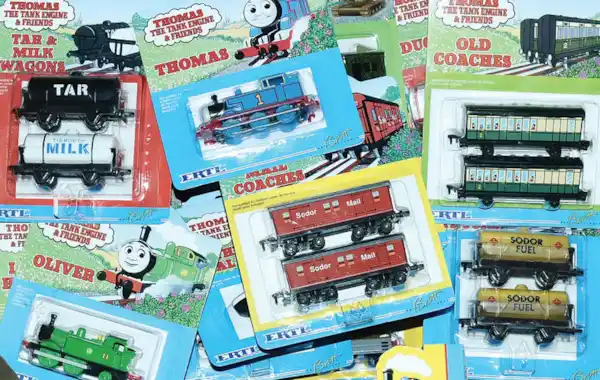14 April 2025
|
Remembering collectables that found fame through books, television or the silver screen.
Ask any non-railway enthusiast to nominate the most famous train they can think of, and you might expect the ‘Flying Scotsman’. Others might give you ‘Mallard’, the world speed record holder for steam.
But there is another unassuming little engine which, despite being entirely fictitious, is more famous and influential across the world than those two. He’s useful, he’s been doing it for 70 years, he’s Thomas the Tank Engine.

Who Created Thomas the Tank Engine Books?
The series of Thomas books famously originated as stories told by The Rev W Awdry.
Awdry wrote them for his young son Christopher who was suffering from measles. It was Awdry’s wife Margaret who encouraged her husband to submit the stories to a publisher. She noticed the scarcity of post war books for children and saw an opportunity.
The first book came out in 1945, entitled The Three Railway Engines. It did not feature Thomas but did introduce us to Edward the blue engine, Gordon the large engine and Henry the green engine. The books were in full colour, which was rare just after the war and would have contributed to their popularity.
They were also in an unusual format. They were landscape rather than portrait, which prompted complaints from booksellers that they were difficult to display.
The series went through several artists in its lifetime, and their work was particularly important in setting the right ambience. Awdry was not the first to add human looks to trains. Rudyard Kipling had previously noticed the elements of humanity in the living, breathing steam engine. However, his work did not lead to an avalanche of marketing products and a multi billion pound brand.
Running through all Awdry’s stories is a strong moral tone; engines may misbehave and precipitate a crisis. They always resolve the issue and redeem the naughty engine. They based all the engines as closely as possible on real prototypes.
Suggested article: The Billinton E2 Class: The Real Thomas the Tank Engine
The Rev W Awdry wrote twenty-six books before stepping down in 1972. Such was the strength of his stories, that Awdry’s son Christopher continued writing more Railway Series books, bringing the total up to forty-two.
Was Meccano the First to Make a Thomas the Tank Engine Toy?
You might have expected the first Thomas train model to come from the innovative, forward looking Tri-ang company. But it was its staid northern cousins, Meccano, that was the first onto the Thomas bandwagon, but it was a half hearted effort.
Having stopped production of O gauge tinplate trains in 1962, it produced a plastic Percy Play Train in 1965. Anyone else would have made it, and people would have considered it junk. But as it signified the last product, it holds a mystical place in the hearts of Hornby collectors.
Described as having an easy to wind, long running clockwork motor. Percy could also be pushed along without damaging the mechanism.
Although the track was crude, you could also use the loco and two wagons on standard O gauge track. They possibly chose Percy over Thomas because he has four wheels rather than six, making a simpler toy.
The box for Percy mentions long playing records, press out model books, postcards and painting books. Thomas merchandise was already in full swing, although future developments were to dwarf the earlier efforts.

Who Is Britt Allcroft and How Did She Bring Thomas to TV?
The catalyst that propelled Thomas to superstar status was of course his arrival on television. In 1979, a feisty TV producer called Britt Allcroft acquired the rights to bring Thomas to the small screen.
In collaboration with the author and later the Awdry family, Allcroft was responsible for nurturing Thomas and maintaining standards of design and artwork for the associated merchandise.
The television series started in 1984, voiced by The Beatles drummer Ringo Starr. The stories feature extensive model railway footage using gauge 1 models which are radio controlled.
How Did Thomas the Tank Engine Influence Model Railways?
Thomas has taken books and television by storm and helped save the model railway industry. Which faced serious competition initially from Scalextric and later, computer games.
After a shaky start, Hornby’s Thomas models have matured into a brilliant range in their own right. Almost as if the manufacturer was free to express itself. Rather than trying to produce completely realistic trains as demanded by the average railway modeler.
From 1985, manufacturers introduced the models in both electric and clockwork versions, adapting many from existing models and creating a whole new area for collectors. They have revived the interest of children in model railways by putting back the play value. Now many of the models are thirty years old they have become increasingly scarce in mint, boxed form. This makes them an obvious opportunity for investment.
Ertl, the manufacturing company, cornered the market in diecast push along Thomas with a huge range, while Brio produced wooden models. Thomas naturally lends himself to being made in wood, but people rarely collect toys made from this material. Could Brio buck this trend?
Bachmann has been producing some excellent HO scale Thomas models since 2002. Still early days for serious collectability, but these products are definitely worth watching. Even more interesting is the G scale range suitable for garden railways, which has been available since 2009.

What Thomas the Tank Engine Merchandise Is Most Valuable for Toy Collectors?
Lunch boxes, bubble bath, duvet covers, wallpapers, pencil boxes, jigsaw puzzles and stamps. The merchandise list is so extensive that it’s easier to say what they haven’t produced in a Thomas version. Any Thomas collector would be wise to specialise. In model railway terms, any Thomas toys in original packaging untouched should command a premium.
Mattel has owned the Thomas brand since 2011, and his popularity shows no signs of waning. The only caveat is that commercial pressure may dilute the traditional values nurtured by Awdry and Allcroft. But that has been an issue which dates back to Thomas’s first illustrator.
Nice to think that Thomas can rise above it, after all he represents a mode of machine which ceased regular use fifty years ago. In the same way that the road sign warning of a railway still depicts a steam train, Thomas will continue to represent the human face of trains for many years to come.
If you enjoy toy collecting, collectors can get the latest collecting news by signing up for the Collectors Club of Great Britain’s newsletter.







